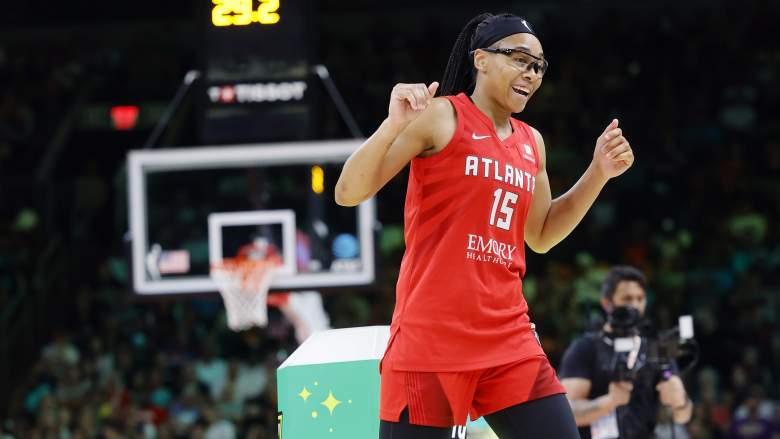
Allisha Gray went home a big winner — in more ways than one — at WNBA All-Star Weekend on Friday night.
The Atlanta Dream guard won both the WNBA skills challenge and three-point contest, becoming the first player to ever sweep the two events. She chose the right time to do it, earning $115,150 in prize money, which is almost two thirds of her annual salary with the Dream ($185,000).
“Now that I think about it, had a good nap, maybe I’ll go on a little golfing spree, shopping spree,” she told ESPN’s Holly Rowe.
She also toyed with the idea of taking her teammates out to dinner, albeit with one condition.
“For my team, yeah, they gotta plan it,” Gray told ESPN. “I’ll just pay the bill.”
Whatever Gray does with her money, her path to earning it was years in the making, from a more lucrative 2020 WNBA CBA to the influx of cash the league has seen from corporate sponsors in the last few years.
There’s a reason for that, of course. The WNBA puts a quality product on the court that has attracted a rapidly growing fanbase. With that, comes larger media rights deals, higher attendance, bigger corporate sponsorships, and just more money in general.
Aflac Pledges $110,000 to WNBA All-Star Friday Winners
Most of Gray’s prize money on Friday comes from a corporate sponsor. Insurance company Aflac pledged $55,000 each to the skills competition and three-point contest winners. By winning both, Gray got the entire pot.
The rest of the money comes from the WNBA CBA. Signed in 2020, the CBA outlines a series of player bonuses they could earn through honors like postseason awards, playoff appearances, and All-Star selections. The CBA promised $2,575 each to the winner of both competitions. Losing participants received $1,030 each.
“This amazing contribution brings us closer to parity with our brothers in basketball,” Players Union President Nneka Ogwumike wrote about Aflac’s contribution on X. “We’re so grateful for Aflac’s commitment to recognizing and celebrating the hard work and talent of the Players!”
The other side of this is the meager payout the WNBA promised, themselves. Even in the WNBA, whose players receive far less money compared to major men’s professional sports, $2,575 is not much incentive. For the most part, these aren’t players on league-minimum salaries. They’re All-Stars, making on the upper end of the league’s salary structure.
Had Aflac not stepped in, Gray’s payout for sweeping the event would have been less than 3% of her total salary.
The 2020 CBA Was an Improvement, But Expect Further Change
As outdated as the current CBA looks, it’s a massive improvement regarding player pay compared to the previous edition. For example, the league rookie minimum in 2020, the first year of the current deal, was $57,000. Under the previous agreement, it would have been only $42,728. The veteran maximum in 2020 was $215,000, compared to $119,500 under the last CBA.
The previous CBA also did not provide any bonuses for skills competition and three-point contest winners, so even $2,575 is a step up. The existing bonuses under the last CBA all saw modest increases in the new one ($2,575 for an All-Star Game participant vs. $2,500, for example).
It was an improvement. And it’s set the stage for an even bigger leap. The players will almost certainly opt out of the CBA at the end of the season, allowing them to renegotiate with the league. Since they signed the last CBA, the WNBA as seen massive jumps in popularity — shown both in ratings and attendance records. It also received a $75 million cash infusion from outside investors last year as corporate sponsors like Aflac and State Farm have rushed aboard.
With the league set to begin a new $2.2 billion media rights agreement — a figure that will annually net the league quadruple its current payout — there’s plenty more to go around (even if Cheryl Miller is right that it’s a “lowball” offer).
It’s a good time to be a WNBA player. And it’s getting better.
Comments
How Allisha Gray Earned 6 Figures in WNBA All-Star Prize Money